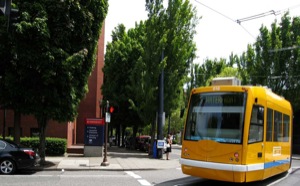
The closest mode of public transportation to my place of residence is the Portland Streetcar.
The city, happily, is expanding the streetcar line across the Willamette River to the east side of the city, and due to this expansion, the existing line was shut down for a few weeks as they laid new track.
In lieu of my beloved streetcar, they pressed a city bus into service that followed almost the same route. I ride the bus frequently, and thought nothing of it…musing, “Bus, streetcar, what’s the difference?”
Boy, was I wrong!
The same people. The same stops. Nearly the same route. But, on a bus, it was a completely different experience. And, in an informal survey of the three other members of my family, they all felt the same way. The question was, “Why?” Was it the smoother ride of the streetcar? Was it the romance of riding the rails? None of us could really put our finger on it, but the question remained in the back of my mind.
When the the electric trolley resumed its laps around the west side of our fair city, I was still asking myself, why is this more special? More enjoyable? Just more!!
As an answer, I began circling around the concept of street activation and the dialog that exists in functioning places between the denizens of the streets, the sidewalks, and the surrounding buildings. The exchanges that make a place sing. And, I realized, that the streetcar travels slowly and has large windows, and somehow is able to become a part of that dialog, a piece of the conversation. While riding, you feel that you are IN the city, participating in that exchange.
In contrast, a bus really puts you ABOVE the city. It is a paradigm of the automobile culture. You are traveling more quickly. There is no interaction. You are not a part of a dialog. You are traveling through, or moving toward somewhere else…you are not, in the moment, a member of the community through which you are progressing.
(For an interesting read on streetcars and their history, check out this excerpt from Patrick Condon’s new book “Seven Rules for Sustainable Communities: Design Strategies for the Post Carbon World.”)